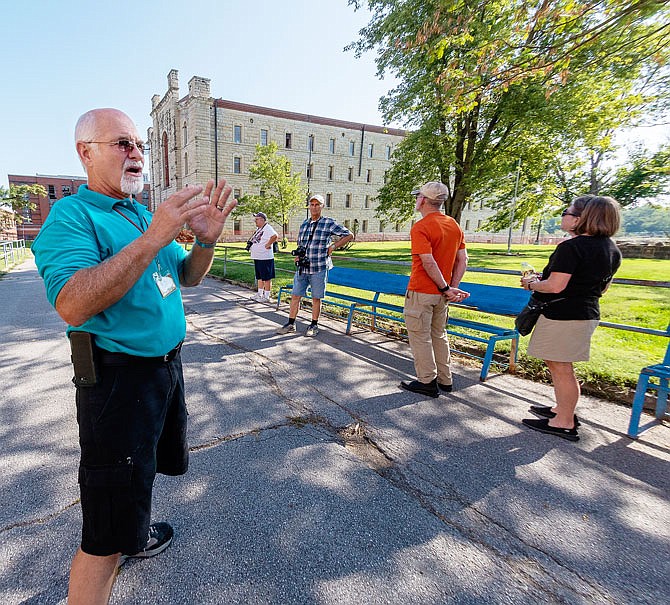For the first time since the May 22 tornado, guests were allowed to see inside the walls of the Missouri State Penitentiary on Tuesday morning.
A guided history tour showed how much of the property is standing firm and the millions of dollars worth of repairs needed.
Eleven out-of-town guests walked into Housing Unit 1 at 115 Lafayette St., which was once the female prison department and control center for MSP. Tour guide Larry Neal, a former employee of the prison's maintenance department, told the group to take lots of pictures throughout their visit.
A gap in a stone wall can be seen where work factories once stood and the gas chamber remains. The tornado ripped through that space before continuing on to the Missouri River in North Jefferson City.
Before the tornado, Neal said, he told guests to take pictures of the wall because it could be removed in the future. He didn't expect a tornado to do the work for the state.
This and other stops on the tour have changed to include additional layers of MSP's history.
Housing Unit 4 excluded from tours
Guests were not allowed to enter Housing Unit 4, built by inmates in 1868, due to severe damage to the roof. The building is considered dangerous because of falling hazards, according to the state.
"The building really epitomized what MSP meant to those who worked here," Neal said.
When the prison closed in 2004, employees received coins that had an image of Housing Unit 4 on one side, he said.
From outside the structure, Neal told stories of the 151-year-old housing unit that has been extremely popular on the tour. Guests also viewed photos of the building from before and after the tornado.
The 2019 tornado is not the first time the roof was damaged, Neal said. In 1910, a storm took part of the roof, and in 1927, the roof was burned by a stove.
"I'm glad it's standing," Neal said. "I came in after the tornado and took pictures, and you can see daylight inside. It just broke my heart because I didn't know if they could even salvage the place."
There are no cracks in the foundation of the building, Neal said.
It may cost more than $2 million to repair Housing Unit 4, according to July cost estimates from the Missouri Office of Administration.
The Jefferson City Convention and Visitors Bureau is working with OA on how to move forward, CVB Executive Director Diane Gillespie said.
Tours are scheduled through the CVB. The state, which owns much of the MSP property, conveyed nearly 32 acres of the old prison to Jefferson City in summer 2017. The state and city finalized the conveyance more than a year ago.
More than $4.2 million in repairs is estimated for Housing Units 1, 2 and 3. The CVB does not conduct prison tours in Housing Unit 2.
To supplement going into Housing Unit 4, the two-hour history tour will temporarily include the solitary confinement and death row area. The area is typically shown on the three-hour history tour, which the CVB is not providing at this time.
Tour guides also fill time with interesting stories that make each tour unique.
Mark and Janie Keeley traveled from Oklahoma to see family in Columbia and were determined to go on the tour Tuesday. The highlights of the day were hearing stories from someone who had experiences inside, they said.
"It's real," Mark Keeley said. "It's not all fancied up inside of here. Having a former employee is a really good idea. It's all believable, not something he studied out of a book. It's the real deal."
Unearthed cells previewed
The CVB and OA are working on a new tour stop.
Buried cells were last seen in 1985 between Housing Unit 2 and Housing Unit 3.
During a construction project at that time, the Centennial Cells were discovered and shown to employees, Neal said.
"They looked like they were freshly painted on the inside," Neal said. "They must have been white-washed or something right before they were covered back up."
Inside, the cells were very small, he said. He stretched his hands out to his sides to show the width - a little bit longer than his arms' width.
"There was a little square opening in the back," Neal said. "(And) some kind of vent. It looked like there were solid wooden doors that may have had a window in them - probably some kind of food slot."
The cells could date back to the 1800s, he added. None of the employees who had been there for some time knew the cells were buried there.
Staff expressed excitement that tours are back for the remainder of the 2019 season, which ends Nov. 30.
"I love this place," Neal said. "I love telling my stories. I was heartbroken when the tornado happened; I thought we'd never get to them again. It's such a piece of Missouri history."
Gillespie told the Jefferson City Council on Monday the CVB had laid off 64 part-time seasonal employees after the tornado. All of them were brought back for the two-hour ghost tours and two-hour history tours, she added.
On the web:
Visitors can check availability for the two-hour history tours and two-hour ghost tours on the MSP website.

